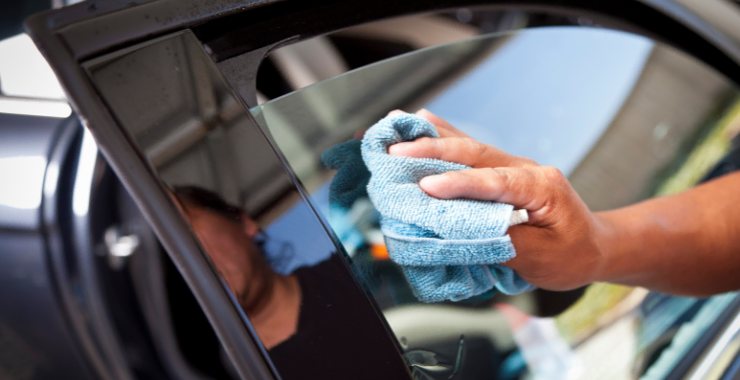Maintaining clean tinted car windows is critical for longevity and appearance. Tinted windows offer benefits like UV protection, privacy, style, and reduced glare. However, improper cleaning can cause scratches, peeling, and haze. This article covers best practices for safely washing tinted glass without damage.
Understanding Tinted Windows
What is a Window Tint Film?
Window tint film is a thin polyester layer that is expertly applied to the interior glass surfaces of a vehicle. This transparent yet tinting film blocks UV rays and controls heat and light transmission into the cabin. Aftermarket window tint is installed after a car purchase, while factory tint is installed directly on the assembly line.
The main differences have to do with quality, durability, darkness levels and legality restrictions. It’s critical to understand that tint film can become irreversibly harmed during cleaning through abrasion, chemical damage or heat distortion. The major players in the tint market are dyed, metalized, ceramic and carbon films which each require customized cleaning techniques. Check this article to know the cost considerations for tinting car windows.

Preparing to Clean Tinted Windows
To properly clean tinted windows, gather supplies that are specifically designed to be tint-safe: Use an ammonia-free automotive glass cleaner without additives or fragrances that could interact poorly with tint glue or dyes. Choose high-quality microfiber towels which are super plush, lint-free and safely non-abrasive for delicate surfaces. Have distilled water on hand to wipe clean water spots and mineral deposits without introducing new contaminants.
Before cleaning, park your car in a shaded area to prevent rapid drying and stubborn streaking issues. Roll down all windows a few inches to allow greater range of motion and access to top and side edges of glass. Carefully remove any parking stickers and old inspection decals by gently slicing the adhesives with a fresh razor blade.
Step-by-Step Tinted Window Cleaning
The safest procedure for washing tinted windows without inflicting swirls, scratches or lifting is to follow these simple step-by-step instructions:
- Remove loose surface debris like dust or tree sap by gently brushing with a clean microfiber glove or blowing compressed air.
- Lightly spray your preferred ammonia-free glass cleaning solution directly onto your microfiber towel instead of the delicate tint film.
- Gently wipe clean using straight overlapping strokes moving from top to bottom of each window pane. Avoid any circular rubbing motions or pressure which can leave micro-abrasions and swirled scratches over time.
- Flip the towel to a dry side and buff the surface thoroughly to eliminate water spots and streaks.
- Repeat cleaning procedure on interior tinted surfaces for best clarity and UV protection.
- Pay extra attention to bottom window edges, corners and rubber seals which commonly harbor grime.
- For stuck-on contaminants in hard-to-reach crevices, use a soft-bristled detailing brush and compressed air.
Dealing with Stubborn Stains and Haze
For embedded water spots and mineral residue, pre-soak the affected area with distilled water followed by gentle straight-line wiping to lift deposits without grinding them in. Remember to avoid using any abrasive pads or bristle brushes which could permanently damage the tint.
For tough sticky stains like tree sap that cause visual hazing, try mixing a 50/50 distilled water and white vinegar solution. Thoroughly rinse the cleaned area with plain distilled water afterwards. If you notice any deep scratches, cracking or bubbling of the tint film, immediately consult a professional window tint installer for repairs.
Tinted Window Cleaning Mistakes to Avoid
- Harsh cleaners with ammonia that break down tint
- Cleaning in direct sunlight causing rapid drying and streaks
- Scrubbing aggressively with paper towels or sponges
- Forgetting window seals, channels and frames where dirt collects
- Using excessive water leading to bubbling under tint
Read this article if you are attempting to remove tint without proper knowledge.
Maintaining Tinted Windows
Following the proper methods using tint-safe cleaning products and gentle techniques will maintain the sleek appearance and UV protective performance of your tinted windows for years. Get into the habit of cleaning all of your tinted glass surfaces every couple of weeks to prevent lasting damage from dirt and debris accumulation.
If you do notice any significant window tint damage, distortion or discoloration – address these issues right away with a professional tint shop rather than attempting temporary fixes. Your vehicle’s window tint protects you from harsh sunlight daily, so give it the delicate care and maintenance it deserves!
